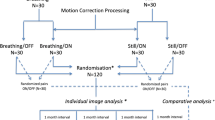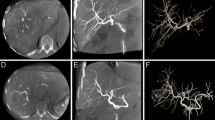Abstract
Purpose
Cone beam CT (CBCT) with planning software is used in intra-arterial liver-directed therapies. Software accuracy relies on high CBCT image quality, which can be impaired by breathing motion. We assessed the impact of a specific MCT on software performance for procedure planning and navigation.
Materials and Methods
Institutional Review Board (IRB)-approved retrospective evaluation of liver-directed therapies from July 2015 to April 2018 was performed. CBCTs with at least one well-defined tumor and noticeable breathing motion were included. Each CBCT was reconstructed with and without breathing MCT (Motion Freeze, GE Healthcare). Automatic tumor-supplying vessel detection was performed on up to 4 tumors in each CBCT reconstruction (Liver ASSIST V.I., GE Healthcare). Vessel detection sensitivity and positive predictive value (PPV) were measured with and without MCT using Digital Subtracted Angiography (DSA) as reference. Preprocedural contrast-enhanced CT was also utilized in some cases to rule out the possibility of extrahepatic supplying vessels.
Results
MCT was applied retrospectively to 18 CBCTs with a total of 30 tumors. At least one supplying vessel was detected for 28/30 (93%) tumors with MCT versus 20/30 (66%) without. On the subgroup of 10 CBCTs (22 tumors, 76 feeders) in which the automatic vessel detection initially worked in both reconstructions, the average sensitivity and PPV increased from 63% (48/76) and 57% (48/84) before MCT to 83% (63/76) and 79% (63/80) after (p = 0.002 and p < 0.001).
Conclusion
Breathing MCT improves planning software performance in CBCT impaired by breathing motion.


Similar content being viewed by others
References
Kakeda S, et al. Usefulness of cone-beam volume CT with flat panel detectors in conjunction with catheter angiography for transcatheter arterial embolization. J Vasc Interv Radiol. 2007;18(12):1508–16.
Wallace MJ, et al. Impact of C-arm CT on hepatic arterial interventions for hepatic malignancies. J Vasc Interv Radiol. 2007;18(12):1500–7.
Cui Z., et al., A systematic review of automated feeder detection software for locoregional treatment of hepatic tumors. Diagn Interv Imaging, 2020.
Deschamps F, et al. Computed analysis of three-dimensional cone-beam computed tomography angiography for determination of tumor-feeding vessels during chemoembolization of liver tumor: a pilot study. Cardiovasc Intervent Radiol. 2010;33(6):1235–42.
Iwazawa J, et al. Comparison of the number of image acquisitions and procedural time required for transarterial chemoembolization of hepatocellular carcinoma with and without tumor-feeder detection software. Radiol Res Pract. 2013;2013:580839.
Minami Y, et al. Tracking navigation imaging of transcatheter arterial chemoembolization for hepatocellular carcinoma using three-dimensional cone-beam CT angiography. Liver Cancer. 2014;3(1):53–61.
Pichon E, et al. Development and preliminary evaluation of software for planning selective liver embolizations from three-dimensional rotational fluoroscopy imaging. Int J Comput Assist Radiol Surg. 2008;3(5):405.
Ronot M, et al. Cone-beam CT angiography for determination of tumor-feeding vessels during chemoembolization of liver tumors: comparison of conventional and dedicated-software analysis. J Vasc Interv Radiol. 2016;27(1):32–8.
Lee IJ, et al. Cone-beam CT hepatic arteriography in chemoembolization for hepatocellular carcinoma: angiographic image quality and its determining factors. J Vasc Interv Radiol. 2014;25(9):1369–79.
Guo M, et al. Reconstruction of a high-quality volumetric image and a respiratory motion model from patient CBCT projections. Med Phys. 2019;46(8):3627–39.
Dioguardi Burgio M, et al. Clinical impact of a new cone beam CT angiography respiratory motion artifact reduction algorithm during hepatic intra-arterial interventions. Eur Radiol. 2020;30(1):163–74.
Soliman MM, et al. Use of virtual injection software to aid in microcatheter positioning during transarterial chemoembolization. J Vasc Interv Radiol. 2019;30(10):1646–8.
Iwazawa J, et al. Clinical utility and limitations of tumor-feeder detection software for liver cancer embolization. Eur J Radiol. 2013;82(10):1665–71.
Lee IJ, et al. Cone-Beam Computed Tomography (CBCT) Hepatic Arteriography in Chemoembolization for Hepatocellular Carcinoma: performance depicting tumors and tumor feeders. Cardiovasc Intervent Radiol. 2015;38(5):1218–30.
Klugmann A, et al. Deformable respiratory motion correction for hepatic rotational angiography. Comput Med Imaging Graph. 2018;66:82–9.
Funding
This study was not supported by any funding.
Author information
Authors and Affiliations
Corresponding author
Ethics declarations
Conflict of interest
Homan Yarmohammadi has research funding from RSNA Scholar Grant, SIR Ernest Ring Academic Development, Guerbet Group and Thompson Foundation. He is an advisory board member of Management of Ascites Advisory Board of BD Medical and Management of HCC Advisory Board of Genentech. Stephen Solomon has consulting fees from BTG, Johnson & Johnson, Varian, XACT Robotics, Endoways and Aperture. He holds grants from GE Healthcare, AngioDynamics, Elestra, Johnson & Johnson. He is a shareholder of Aperture and Johnson & Johnson. All the other authors declare that they have no conflict of interest.
Ethical Approval
All procedures performed in studies involving human participants were in accordance with the ethical standards of the institutional and/or national research committee and with the 1964 Helsinki Declaration and its later amendments or comparable ethical standards. For this retrospective study, formal consent is not required, and was waived by institutional IRB.
Informed Consent
This research was funded in part through the NIH/NCI Cancer Center Support Grant P30 CA008748
Consent for Publication
For this type of study, consent for publication is not required.
Additional information
Publisher's Note
Springer Nature remains neutral with regard to jurisdictional claims in published maps and institutional affiliations.
Rights and permissions
About this article
Cite this article
Ridouani, F., Doustaly, R., Yarmohammadi, H. et al. Retrospective Use of Breathing Motion Compensation Technology (MCT) Enhances Vessel Detection Software Performance. Cardiovasc Intervent Radiol 44, 619–624 (2021). https://doi.org/10.1007/s00270-021-02767-8
Received:
Accepted:
Published:
Issue Date:
DOI: https://doi.org/10.1007/s00270-021-02767-8




